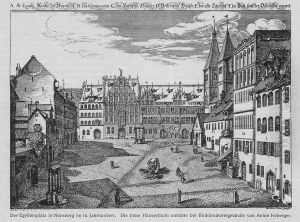Anton Koberger Paintings
Anton Koberger was born around 1440-1445 in Nuremberg, a city that was then one of the Holy Roman Empire's most important cultural centers. He died in 1513. Koberger was not just an artist in the traditional sense but was more significantly recognized as the most successful publisher and printer of his time in Germany, and indeed, across Europe. His work and influence span the transition from the late medieval period into the early stages of the Renaissance in northern Europe, a time marked by significant developments in art, literature, science, and the spread of knowledge, largely facilitated by the invention of the printing press.
Koberger's career in printing and publishing began in the 1470s, after he had completed a series of apprenticeships, likely in goldsmithing, which was his family's trade. By 1470, he established his own printing business in Nuremberg, which quickly expanded to become the largest of its kind in the late 15th century. Over his career, Koberger published more than 200 titles, ranging from religious texts and humanist writings to scientific works and classical texts, thereby playing a pivotal role in the dissemination of knowledge during the Renaissance.
Perhaps his most famous publication is the Nuremberg Chronicle, printed in 1493. This work, officially titled 'Liber Chronicarum,' is an illustrated world history from the creation of the world until the 1490s, and it showcases the ambitious scope of Koberger's publishing ventures. The Chronicle is notable for its extensive use of woodcut illustrations, with over 1,800 images included in its pages, making it one of the most richly illustrated books of the 15th century. The artwork for these illustrations was likely completed by Michael Wolgemut and Wilhelm Pleydenwurff, with the possibility that the young Albrecht Dürer, who was Wolgemut's apprentice at the time, also contributed.
Koberger's influence extended beyond his printing empire. He was also Albrecht Dürer's godfather, indicating his close connections with the artistic community of Nuremberg. His publishing house served as a model for others across Europe, influencing the spread of printing technology and the growth of the publishing industry. Through his work, Koberger contributed significantly to the intellectual and cultural developments of the Renaissance, making knowledge more accessible than ever before.
Despite his profound impact on printing, publishing, and the Renaissance culture, detailed personal information about Koberger is scarce, and much of what is known about him comes from the records of his publishing house and the legacy of his printed works. His death in 1513 marked the end of an era in publishing, but his contributions laid the groundwork for future developments in the dissemination of knowledge and the growth of the printed book as a central medium for cultural exchange and learning.
